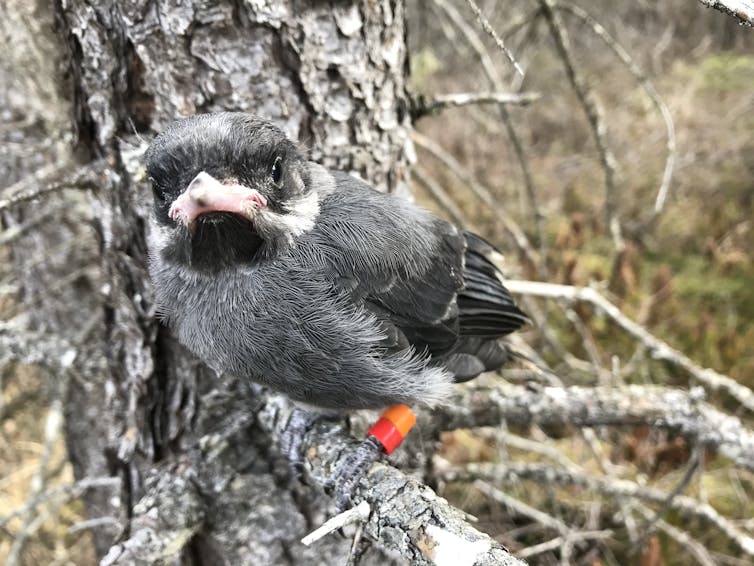Canada News
For Canada jays, sibling rivalry can be deadly as winner takes all

Canada jays are full-time residents of North Americas’s boreal forests, and they rely on stored food items to survive through the winter. (Photo By Cephas/Wikimedia Commons, CC BY-SA 3.0)

(M. Fuirst), Author provided
In the animal kingdom, sibling conflicts — mostly in the form of competition for food from parents — are fairly common in birds. Sometimes death can occur as a result of this competition, but siblicide almost always occurs when young are still in the nest.
Conflicts among siblings suggest a trade-off between competition for resources and the benefits of having blood relatives. In many species, despite sibling conflicts, juveniles have the choice to stay within the home territory or leave and seek out a new home.
But Canada jay siblings will fight one another for their home territory after leaving the nest. If they lose, they must leave.
My colleagues and I compared the survival and reproductive benefits of being the dominant juvenile, while taking into account the costs related to kicking out closely related siblings. This study on sibling conflict in wild animals is the first to measure the cost of kicking out siblings. The cost of kicking out close relatives is that individuals that might help spread the family genes are instead sentenced to exile, where they have a high probability of dying.
Canada jay behaviour
Using six years of radio-tracking data and our 50 years of data on individually marked Canada jays in Algonquin Provincial Park in central Ontario, we were interested in whether the benefit of kicking out your siblings outweighed the cost.
To do this, we examined the survival and lifetime reproductive success of all known dominant juveniles and ejectees. Because Canada jays can live up to 17 years, it took over five decades to collect lifetime data on a sufficient number of individuals in the population.
Canada jays are full-time residents of North Americas’s boreal forests, and they rely on stored food items to survive through the winter. They are only one of two known species (the other being the closely related Siberian jay) in which sibling conflicts result in expulsion of one or more siblings from the home territory after juveniles have left the nest.
About six weeks after offspring have left the nest but still remain in the home territory being fed by parents, an intense battle commences. The end result is the ejection of weaker siblings (ejectees) from the home territory by the dominant juvenile. By being forced out, ejectees must find a new home before the onset of winter.
We found that while dominant juveniles do incur a cost of kicking out their siblings, the benefits of higher first-year survival and long-term reproductive success outweigh the costs of sibling expulsion.
Winner takes all
The decision to kick ejectees out of the home territory has a tremendous trade-off for Canada jays. Our research found that by remaining as the sole offspring at home, a dominant juvenile has a higher probability of survival in their first year and more successful reproduction in adulthood.
This is likely because the dominant juvenile does not need to find a new place to live, is able to live in a group in the first year of its life and is already familiar with the habitat where they can store food for the winter.
And while the dominant juvenile reaps those benefits, ejectees are sentenced to a risky first year of life, where they are less likely to survive.
It is not necessarily a beneficial thing to kill or expel a sibling, even if the ability is there. Siblings share genes, so harming a sibling has a negative effect on the genetic success of an individual’s lineage. However, in the animal world, such behaviours come down to costs and benefits.
If, by monopolizing resources in the nest, a sibling is able to gain a lifetime benefit that outweighs the cost it would otherwise incur by sharing resources, then the trait would be considered adaptive and likely spread in the population over time.
In the case of Canada jays, the expelled siblings don’t all die. Our research found that although ejectees have lower survival rates over their first summer, most that survive are adopted by unrelated adults. We saw juveniles with parents who did not have young of their own. A smaller proportion found a mate to breed in their first year or remained alone.

(M. Fuirst), Author provided
Sibling behaviour and survival
In Algonquin Provincial Park, the number of Canada jay territories has declined by over 75 per cent in the last four decades. This trend is due to warming temperatures and higher frequencies of freeze-thaw events that spoil the highly perishable food that jays store for winter.
Our study is important for the field of behavioural ecology, and it provides novel insights into the evolutionary drivers of sibling conflicts. With the Algonquin Park jay population in major decline, understanding the behaviours of Canada jays is essential to understand the challenges individuals may be facing to survive.![]()
Matthew Fuirst, Instructor, Integrative Biology, University of Guelph
This article is republished from The Conversation under a Creative Commons license. Read the original article.





















